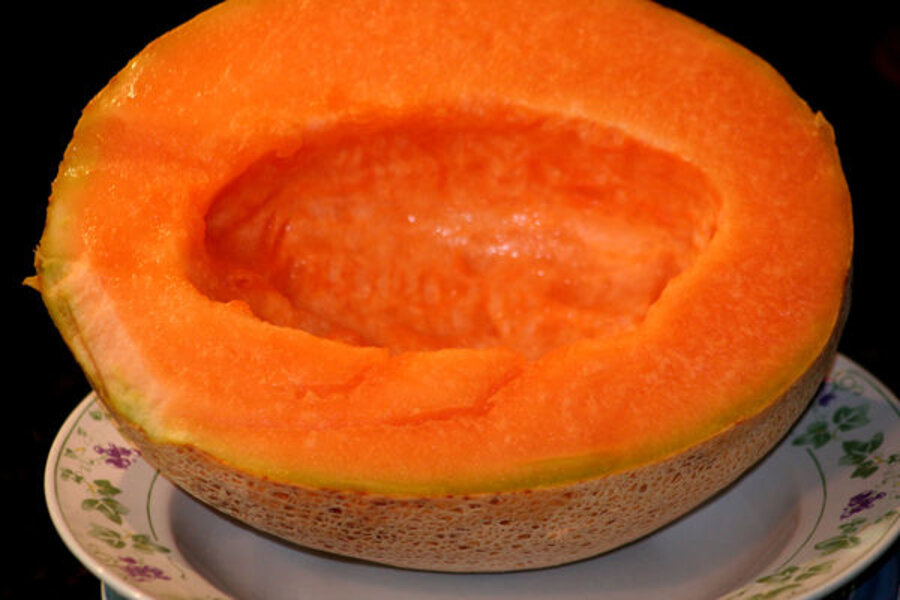How to grow (and serve) the perfect July 4 cantaloupe salad
Loading...
Muskmelons -- also called cantaloupes or just lopes here in the South -- are ambrosia on a vine, says Anne the gardener. In fact, there is a muskmelon variety called Ambrosia. It is delicious. Another fairly new taste treat is Athena. It has fast become one of my favorites.
I hope that you have planted some melons, and they are filling up your garden spaces. They are going to be running six to eight feet between the rows. Heavy mulch around the roots and under the vines will conserve moisture and keep weeds down.
How to plant and grow
Melons are hot weather lovers, so plant them after the soil has warmed up in the spring. They will need about 75 to 90 days to mature before the first frost. My article at GardenSmart has more growing information.
You can plant them in “hills,” meaning three to four seeds in a circle. I used to think the term “hill” meant to mound the soil and plant the seeds in it.
Not so, according to Dr. Powell Smith, who is a Clemson University Extension agent. But it is perfectly OK if you want to continue to plant them in raised hills. I did it for years with no ill effects to me or my melons.
Melons grow according to our spring and summer cycles. Spring rains keep the melon plants watered as they grow. Then, in late summer, when rains diminish and the melons are large but not yet ripe, let them go dry between watering to increase the sweetness of the melon flesh.
If you covered your vines with row covers to keep disease and destructive insects at bay, do not forget to uncover them as soon as blossoms appear on the plants. Pollinators need to have access to the blooms or your melons will not swell into heavenly fruit.
It is easy to tell when a muskmelon -- aka cantaloupe -- is ripe. A slight tug on the stem causes a ripe melon to fall off the vine.
If you have yard turtles, you will need to put up some kind of a barrier around your melon patch. I suspect there are more than a few squirrels getting a bad rap for turtle chomping. Box turtles love muskmelons.
Cantaloupe stars in a fruity salad
With the Fourth of July coming up, this salad with cantaloupe stars is a great attention getter for a party or picnic, says chef Linda Weiss. Simple and easy,
I made a big platter of baby greens, and used the cantaloupe stars, blackberries, and green grapes. I drizzled the salad with a good store-bought fat-free raspberry-pecan vinaigrette dressing, which has a wonderful flavor. The raspberry-pecan flavor of the vinaigrette enhances the sweetness of the cantaloupe. In other words, the flavors “marry” well.
But if you feel more comfortable making your own vinaigrette or salad dressing, then I suggest that you serve raspberry vinaigrette, French, or Catalina style dressing with the salad.
This is also a beautiful way to serve cantaloupe for brunch. Just imagine a crystal or glass bowl of cantaloupe stars, green grapes, strawberries, blueberries, and mint. How beautiful will that be? Children will love it, too, and this will set you apart from the other cooks.
You can make this a main-dish salad by adding grilled chicken and/or feta cheese.
Cantaloupe Stars With Blackberries & Grapes on Baby Greens
Mixed baby greens to serve 6
Cantaloupe stars (see directions below)
Blackberries or blueberries
Green grapes
Strawberry halves (optional)
Fresh mint, cut into narrow ribbons
Lime zest (to taste)
Raspberry-pecan vinaigrette (store-bought is fine)
Put the mixed baby greens on a large platter. Place the cantaloupe stars around and on the greens. Add the blackberries, grapes (and strawberry halves if using them). Add the fresh mint and lime zest to the top of the salad. Add the vinaigrette and serve immediately. Serves 6.
Cutting the cantaloupe -- Use a sharp knife and peel the melon by standing the melon on one end and cutting down the sides. Cut the melon into quarters and then lay the quarter horizontally, and then slice the quarters through the middle horizontally. The melon should now be thin enough to use the cookie cutters to make stars. Put the stars in a bowl until ready to use, and save the leftover pieces for another use.
Editor's Note: To read more of Anne and Linda's "how to grow and prepare" series, click here.
-----
Linda Weiss and Anne Moore met while Linda was the food editor and Anne was the garden editor for South Carolina Homes & Gardens magazine. They now write articles for the ETV GardenSMART television show website, where Anne is the horticulture editor, gardening consultant, and e-newsletter editor. Anne has written for magazines and newspapers. She is a member of and a recipient of a Silver Award for magazine writing from the Garden Writers Association. Linda is a personal chef. She attended Le Cordon Bleu of Paris’ catering program, has appeared as a guest chef on numerous television shows, has been a culinary educator for 10 years, and a food writer for a number of magazines. She is a professional member of The James Beard Foundation and the Southern Foodways Alliance. She has written a cookbook, "Memories From Home, Cooking with Family and Friends."





